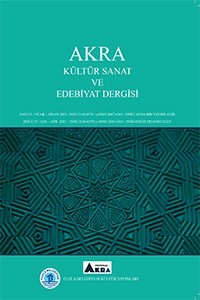NASREDDİN HOCA FIKRALARINDA ÖLÜM VE ÖTEKİ DÜNYA ALGISI
Nasreddin Hoca fıkraları, ölüm, öteki dünya, mizah
PERCEPTION OF DEATH AND THE OTHERWORLD IN NASREDDİN HODJA ANECDOTES
Nasreddin Hodja anecdotes, death, otherworld, humor,
___
- Arslan, Mehmet-Burhan Paçacıoğlu (1996); Letâ’if-i Hoca Nasreddin, (hzl.), Dilek Ofset Matbaacılık, Sivas.
- Ateş, Mehmet (2001), Mitolojiler ve Semboller Anatanrıça ve Doğurganlık Sembolleri, Ak-siseda Matbaası, İstanbul.
- Charrier, J. P. (2000); Bilinçdışı ve İnsan, (çev. Hüseyin Portakal), Cem Yayınevi, İstanbul.
- Dökmen, Üstün (2003); Sanatta ve Günlük Yaşamda İletişim Çatışmaları ve Empati, Sistem Yayıncılık, İstanbul.
- Duman, Mustafa (2008); Nasreddin Hoca ve 1555 Fıkrası, Heyamola Yayınları, İstanbul.
- Ergin, Muharrem (1989); Dede Korkut Kitabı- I/Giriş-Metin-Faksimile, Türk Tarih Kurumu Basım Evi, Ankara.
- Fuat, Memet (2004); Nasreddin Hoca Fıkraları, Türkiye İş Bankası Kültür Yayınları, İstanbul.
- Fromm, Erich (2005); Kendini Savunan İnsan, (çev. Devrim Doğan Yüzer), İlya Yayınları, İzmir.
- Goleman, Daniel (1995); Duygusal Zekâ/Neden IQ’den Daha Önemlidir?, (çev. Banu Seç-kin Yüksel), Varlık/Bilim Yayınları, İstanbul.
- Kierkegaard, Soren (2004); Kaygı Kavramı/Dogmatik Kalıtsal Günah Sorunu Üzerine Psikolojik Açıdan Basit Bir Tartışma, (çev. Vefa Taşdelen), Hece Yayınları, Ankara.
- Lawrence, David Herbert (2004); Ruhsal Çözümleme ve Bilinçdışının Doğaçlaması, (çev. Erol Esençay), İlya Yayınevi, İzmir.
- Levinas, Emmanuel (2006); Ölüm ve Zaman, (çev. Nami Başer), Ayrıntı Yayınları, İstanbul.
- Önal, Mehmet Naci-Aslı Erten (2013); “Türk Halk Kültüründe Öte Dünya Tasavvuru”, Aİ-BÜ Sosyal Bilimler Enstitüsü Dergisi, Semih Tezcan’a Armağan, c.13, Yıl:13, s. 261-292
- Örnek, Sedat Veyis (2014); Türk Halkbilimi, Bilge Su Yayınları, Ankara.
- Özçelik, Mustafa-Funda Koçer Yeşilyurt (2012); Minyatürlerle Menâkıb-ı Hoca Nasreddin, Akşehir Belediyesi Kültür Yayınları, Konya.
- Özkan, İsa (1999); Huca Nasreddin Mezeklere (Nasreddin Hoca Fıkraları), Tika Yayınları, Ankara.
- Roux, Jean-Paul (1999); Altay Türklerinde Ölüm, (çev. Aykut Kazancıgil), Kabalcı Yayınevi, İstanbul. Sakaoğlu, Saim (2005); Nasreddin Hoca Fıkralarından Seçmeler, Akçağ Yayınları, Ankara.
- Sertdemir, Nahit (2017); Bir Mutasavvıf Gözüyle Nasreddin Hoca/Fıkraların Zahiri ve Ta-savvufi İzahları, Ensar Yayınları, İstanbul.
- Steiner, Reinhard, (2006); “Ölüme Karşı Eliaz Canetti Örneği”, Ölüm ve Felsefe, İthaki Yayınları, 41-51.
- Tokmakçıoğlu, Erdoğan (2004); Bütün Yönleriyle Nasrettin Hoca, Geçit Kitabevi, İstanbul.
- Tura, Saffet Murat (2002); Şeyh ve Arzu, Metis Yayınları, İstanbul.
- Yakıcı, Ali (1997); “Türk Dünyasından Derlenen Nasreddin Hoca Fıkralarında Rüya Motifi”, Uluslararası Nasreddin Hoca Bilgi Şöleni (Sempozyumu) Bildirileri 24-26 Aralık 1996, İzmir, Atatürk Kültür Merkezi Yayınları, Ankara, s. 139-148. (bk. Vilayet Guliyev, Yirmi Üç Molla Nasreddin, Azerbaycan Gençlik Neşriyatı, Bakü 1992.)
- Yıldırım, Ali (2017); “Türkü Sözlerindeki Metaforik Anlatım”, Akra Kültür Sanat ve Edebiyat Dergisi, S. 13, Eylül-Aralık, s. 71-82.
- http://www.egitimhane.com/efendimiz-sav-uyariyor-ahir-zaman-belki-bu-zaman-erişim tarihi 21.12.2017
- ISSN: 2148-0370
- Yayın Aralığı: Yılda 3 Sayı
- Başlangıç: 2013
- Yayıncı: Tuzla Belediyesi
MALATYA MASALLARI'NDA MİTİK VE ŞAMANİSTİK UNSURLAR
Yu-, Yuğ-, Yuv- FİİLLERİ ÜZERİNE
ŞİİRDE BİÇİM BAĞLAMINDA YENİLİK - MÜKEMMELLİK ARAYIŞLARI VE PARNASİZMİN KISA TARİHİ
Salim DURUKOĞLU, Ayşe Sinem TOPRAK
ÇOLPAN'IN ŞİİRLERİNDE ÖZGÜRLÜK ÖZLEMİ VE ÇOLPAN YILDIZI İMGESİ
ORHUN KIYILARINDAN MENDERES HAVZASINA AKAN SÖZ VE SÖYLEYİŞ
SOSYAL DEĞİŞİMLER EVRİMİNDE DEĞİŞMEYENLER GERÇEĞİ VE AYTMATOV ESTETİĞİ-2
NASREDDİN HOCA FIKRALARINDA ÖLÜM VE ÖTEKİ DÜNYA ALGISI
ALİ FUAD BAŞGİL’İN ‘GENÇLERLE BAŞBAŞA’ ADLI ESERİNDE ÖNE ÇIKAN DEĞERLER
